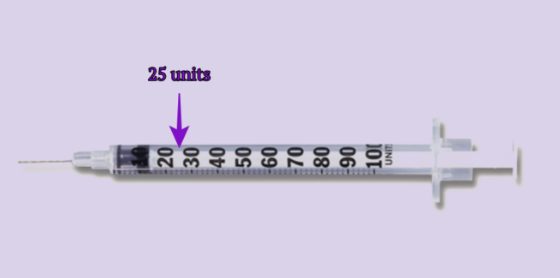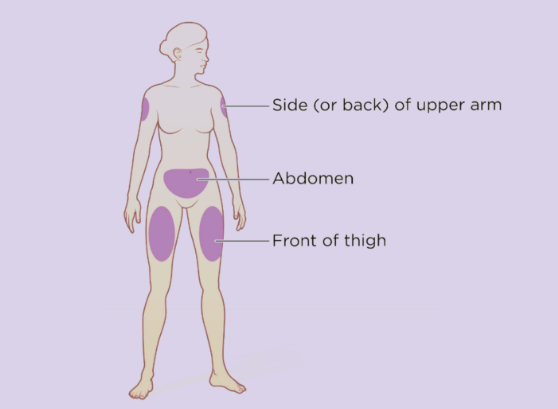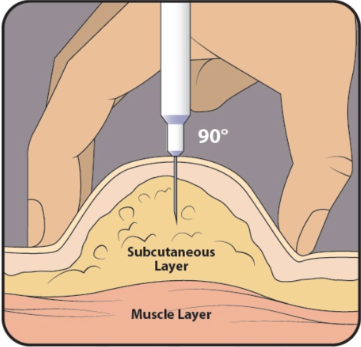
Subcutaneous Injections (Sub-Q) Guide
Subcutaneous (sub-Q) injections are a safe and effective way to deliver medication just under the skin, where it’s absorbed slowly into the bloodstream.
This guide is designed to walk you through every step of the process—from understanding what subcutaneous injections are, to choosing the right site, preparing your materials, and injecting with confidence. Whether you’re new to self-injection or just need a refresher, we’re here to help you feel informed, capable, and supported every step of the way.
Subcutaneous Injections (Sub-Q)
All GLP medications are given subcutaneously. A subcutaneous injection is a shot given into the fat layer between the skin and muscle. Subcutaneous injections are used to give very small amounts of medicine.
About the Syringe
There are 3 parts to a syringe: the needle, the barrel, and the plunger. The needle goes into your skin. The barrel holds the medicine and has markings on it like a ruler. The plunger is used to get medicine into and out of the syringe. We typically request insulin syringes. These hold a maximum of 1 mL of medicine. The syringe has markings from 10 to 100. The marking at 100 is the same as 1 mL. The marking at 50 is the same as 0.5 mL.
How to Draw Up the Medication
First, look carefully at the instructions listed on your medication as well as on your Rx Summary. You will be pulling up the medication by units. The units will vary based on what concentration (the mg amount of medication per mL) your vial is. Concentrations will vary from pharmacy to pharmacy and from medication to medication, so ALWAYS review the Rx Summary for your specific medication before injecting.
It is very important to clean your vial top with an alcohol wipe (or isopropyl alcohol/gauze) before each use to maintain the sterility of your medication. Let it dry completely before puncturing the vial. When you are ready to draw the medication into the syringe, hold the syringe in your hand with the needle pointed up. With the cap still on, pull back the plunger to the line on your syringe for your dose. This fills the syringe with air. For example, if you need 25 units of medicine, pull the plunger to the line halfway between 20 and 30 on the syringe (pictured below). Next, remove the cap and insert the needle into the rubber top of the vial. Do not touch or bend the needle. Depress the plunger and push the air into the vial. This keeps a vacuum from forming so that the medicine will flow easily into the syringe. Turn the vial upside down and hold it up in the air. Make sure that the medicine covers the tip of the needle the entire time. As you did before, pull back the plunger to the line on your syringe for your dose. Remove the needle from the vial. The medicine is ready to inject.

This is an example of a 25 unit dose (drawn halfway between the 20 and 30 mark).
Where To Give the Injection
➔ Abdomen: Uncover your abdomen. You may give an injection within the following area: below the waist to just above the hip bone and from the side to about 2 inches from the belly button. Avoid the belly button.
➔ Thigh: Uncover the entire leg. Find the area halfway between the knee and hip and slightly to the side. Gently grasp the area to make sure you can pinch 1 to 2 inches of skin.
➔ Upper Arm (requires a helper): Uncover the arm to the shoulder. Have the person receiving the injection stand with their hand on their hip. Stand next to and a little behind the person. Find the area halfway between the elbow and shoulder. Gently grasp the skin at the back of the arm between your thumb and first 2 fingers. You should be able to grasp 1 to 2 inches of skin.
How to Choose the Best Place
Keep track of where the injections are given. Write down the date, time, and the site each time you give an injection.
➔ Change sites for the injections: It is important to use a different site each time you give an injection. This prevents scars and skin changes. The sites where injections are given should be at least 1 inch away from each other.
What You Need
- Syringe with medication
- One alcohol wipe
- One sterile 2 x 2 gauze pad or bandaid

How to Give the Injection
Subcutaneous injections can be given straight in at a 90 degree angle or at a 45 degree angle. Give the injection at a 90 degree angle if you can grasp 2 inches of skin between your thumb and first finger. If you can grasp only 1 inch of skin, give the injection at a 45 degree angle.
Open the alcohol wipe: Wipe the area where you plan to give the injection. Let the area dry. Do not touch this area until you give the injection.
Prepare the needle: Hold the syringe with your writing hand and pull the cover off with your other hand. Place the syringe between your thumb and first finger. Let the barrel of the syringe rest on your second finger.
Grasp the skin: With your other hand, grasp the skin.
Insert the needle into the skin: Hold the syringe barrel tightly and use your wrist to inject the needle
into the skin. Once the needle is all the way in, push the plunger down to inject the medicine.- Pull out the needle: Remove the needle at the same angle you put it in. Gently wipe the area with the
gauze pad or place your Band-Aid.

How do I get rid of used syringes and needles?
It is important to dispose of the needles and syringes correctly. Do not throw needles into the trash. You may receive a hard plastic container made especially for used syringes and needles. You can also use a soda bottle or other plastic bottle with a screw lid. Make sure that both the syringe and needle fit into the container easily and cannot break through the sides.